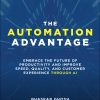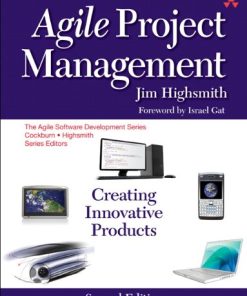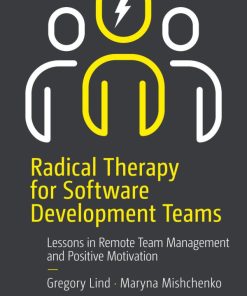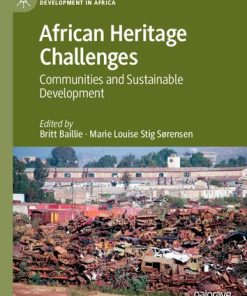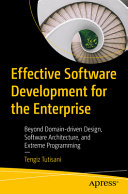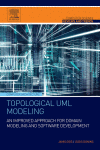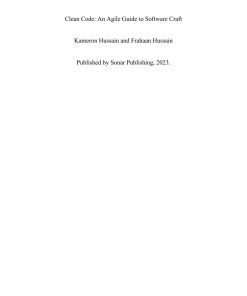(Ebook PDF) Agile Software Development Trends Challenges and Applications 1st Edition by Susheela Hooda 1119896819 9781119896814 full chapters
$50.00 Original price was: $50.00.$25.00Current price is: $25.00.
Agile Software Development : Trends, Challenges and Applications 1st Edition by Susheela Hooda – Ebook PDF Instant Download/DeliveryISBN: 1119896819, 9781119896814
Full download Agile Software Development : Trends, Challenges and Applications 1st Edition after payment
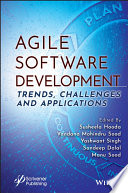
Product details:
ISBN-10 : 1119896819
ISBN-13 : 9781119896814
Author: Susheela Hooda
The book is designed for computer scientists and software engineers.
Agile Software Development : Trends, Challenges and Applications 1st Table of contents:
1 Agile Software Development in the Digital World – Trends and Challenges
1.1 Introduction
1.2 Related Work
1.3 Agile Architecture Trends in the Digital World
1.4 Challenges Faced in the Digital World Through Agile Software Development
1.5 Generic Guidelines to Improve the Agile Transformation in Digital World
1.6 Conclusion and Future Perspective
References
2 Agile Framework Adaptation Issues in Various Sectors
2.1 Introduction
2.2 Agile Followers
2.3 Proposed Work
2.4 Resolution Matrix
2.5 Conclusion and Future Work
References
3 Vulnerability Assessment Tools for IoT: An Agile Approach
3.1 Introduction
3.2 Agile Methodology: SCRUM
3.3 Scrum Agile Benefits for IoT
3.4 Critical Factors for Implementing Agile Methodology
3.5 Conclusion
References
4 Interoperable Agile IoT
4.1 Introduction
4.2 Agile Software Development
4.3 Internet of Things (IoT)
4.4 Agile–IoT Project for Interoperability
4.5 Agile–IoT Project for Smart Domains
4.6 INTER-IoT Framework for Interoperability
4.7 Conclusion
References
5 Functional and Non-Functional Requirements in Agile Software Development
5.1 Introduction
5.2 Agile Requirements Gathering
5.3 Types of Requirements
5.4 Functional Requirement Gathering
5.5 Non-Functional Requirement Gathering
5.6 Testing Functional and Non-Functional Requirements
5.7 Conclusion and Future Scope
References
6 Minimizing Cost, Effort, and Implementation Complexity for Adopting Security Requirements in an Agile Development Process for Cyber-Physical Systems
6.1 Introduction
6.2 Literature Review
6.3 Proposed Methodology
6.4 Conclusion
References
7 A Systematic Literature Review on Test Case Prioritization Techniques
7.1 The Motivation for Systematic Review
7.2 Results
7.3 What Subject Systems Have Been Used to Evaluate Test Case Prioritization Techniques? What is the Type of Programming Platform for Subject Systems?
7.4 Research Gaps
References
8 A Systematic Review of the Tools and Techniques in Distributed Agile Software Development
8.1 Introduction
8.2 Literature Review
8.3 Techniques for DASD
8.4 Tools for DASD
8.5 Conclusion
References
9 Distributed Agile Software Development (DASD) Process
9.1 Introduction
9.2 Distributed Software Development
9.3 Distributed Agile Software Development Team
9.4 Scrum in Global Software Development (GSD)
9.5 Tools and Techniques for Agile Distributed Development
9.6 Conclusion
References
10 Task Allocation in Agile-Based Distributed Project Development Environment
10.1 Introduction
10.2 Task Allocation
10.3 Machine Learning-Based Task Allocation Model
10.4 Conclusion
References
11 Software Quality Management by Agile Testing
11.1 Introduction
11.2 A Brief Introduction to JMeter
11.3 Review of Literature
11.4 Performance Testing Using JMeter
11.5 Proposed Work
11.6 Results and Discussions
11.7 Conclusion
References
12 A Deep Drive into Software Development Agile Methodologies for Software Quality Assurance
12.1 Introduction
12.2 Background Work
12.3 Understanding Agile Software Methodologies
12.4 Agile Methodology Evaluation Framework
12.5 Agile Software Development – Issues and Challenges
12.6 Conclusion
References
13 Factors and Techniques for Software Quality Assurance in Agile Software Development
13.1 Introduction
13.2 Literature Review
13.3 Agile Factors in Quality Assurance
13.4 Quality Assurance Techniques
13.5 Challenges and Limitations of Agile Technology
13.6 Conclusion and Future Scope
References
14 Classification of Risk Factors in Distributed Agile Software Development Based on User Story
14.1 Introduction
14.2 Software Risk Management
14.3 Literature Review
14.4 User Story-Based Classification of Risk Factors in Distributed Agile Software Development
14.5 Future Scope
14.6 Conclusion
References
15 Software Effort Estimation with Machine Learning – A Systematic Literature Review
15.1 Introduction
15.2 Method
15.3 Result
15.4 Discussion
15.5 Conclusion
15.6 Future Scope
References
16 Improving the Quality of Open Source Software
16.1 Introduction
16.2 Literature Review
16.3 Research Issues
16.4 Research Method and Data Collection
16.5 Results and Discussion
16.6 Conclusion and Future Scope
References
17 Artificial Intelligence Enables Agile Software Development Life Cycle
17.1 Introduction
17.2 Literature Survey
17.3 Proposed Work
17.4 Conclusion
References
18 Machine Learning in ASD: An Intensive Study of Automated Disease Prediction System
18.1 Introduction
18.2 Overview of ML
18.3 Case Study
18.4 Conclusion
People also search for Agile Software Development : Trends, Challenges and Applications 1st:
principles of agile software development
types of agile software development
the agile software development model is built based on
user stories applied for agile software development
agile software development life cycle
Tags:
Agile Software Development,Trends,Challenges,Applications
You may also like…
Uncategorized
Business & Economics - Personal Finance
Business & Economics - Management & Leadership
Politics & Philosophy
African Heritage Challenges: Communities and Sustainable Development 1st Edition
Computers - Programming
Politics & Philosophy - Government & Politics
Economic and Social Development of Bangladesh: Miracle and Challenges 1st Edition
Computers - Computers - General & Miscellaneous
Business & Economics - Human Resources
Green Human Resource Management Research: Issues, Trends, and Challenges 1st Edition Pascal Paillé


